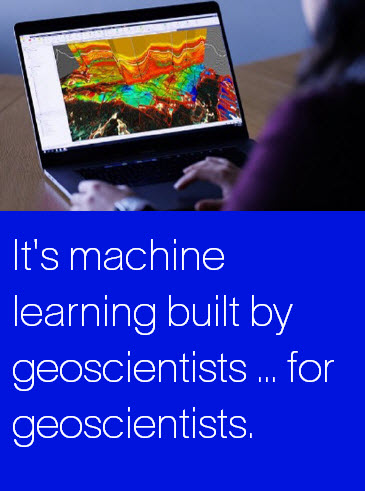
Six years ago, we onboarded Petrel™ subsurface software as a key component of Domain Profiles on Delfi™. Customers using Petrel software on the Delfi digital platform are now taking full advantage of the cloud—experiencing improved data integration with the OSDU® Data Platform, with high-performance seismic streaming, data liberation and consumption. Geoscience workflows are accelerated by machine learning and further empowered by high-performance compute from seismic to reservoir simulation. All these workflows are easily accessible for users of Petrel software.
So guess what?
Machine learning (ML) from the Delfi platform is now available for Petrel software on-premise
Our customers have been using Petrel software, to integrate seismic-to-simulation workflows and accelerate exploration and field development decisions, for more than two decades. We are now very pleased to offer machine learning capabilities from the Delfi platform to all Petrel software users, both on the cloud and on-premise—democratizing AI and driving a performance revolution at scale.

Machine learning is now fully integrated into Petrel software, so there’s no need to move data to standalone applications, you can simply use the ML solution you need and put it to work right away. With end-to-end integration, your workflows are further accelerated, to deliver greater confidence in your decisions, in a significantly shorter time.
ML solutions for horizon and fault interpretation and property modeling
We’re delivering proven machine learning solutions for horizon and fault prediction, extraction, and for property modeling directly into Petrel software. These tasks were previously manually intensive and could take weeks, or even months to perform. As geoscientists upskill themselves and begin using new techniques in Petrel software, the same tasks are now being completed in days or even hours.
Seismic fault detection and extraction

Seismic horizon detection and extraction

Property modeling

Read more
How do you get it?
You can get it now, in on-premise Petrel software releases, Petrel 2022.9, or Petrel 2023.3 and higher, or as part of our globally available cloud solution, the Delfi platform.
We hope that these new machine learning solutions will free up more time for you to generate and analyze more scenarios and focus on geoscience, rather than time consuming manual interpretations. These new solutions have been proven to not only impact exploration and development cycle times, and decision quality for oil and gas, but also rapidly growing areas in the energy transition such as carbon capture, utilization, and storage (CCUS).
“It’s a time of rapid change for the energy industry and our commitment is, as always, to deliver innovative and groundbreaking technology that scales for our customers everywhere.”
—Surender Manral and the Petrel software team

Surender Manral is a senior geoscientist, with over two decades of expertise in subsurface interpretation and reservoir characterization workflows, based in Stavanger, Norway. Currently, he is responsible for the strategy and technology development roadmap for Petrel subsurface software.
Learn more about Machine learning for Petrel on-prem and Petrel 2023.3
Product overview
The Petrel™ subsurface software offers geoscientists and engineers a single application for collaborative workflows with best-in-class technology and leading innovation. From seismic processing to production, Petrel software enables seamless integration across all subsurface domains, helping users to deliver their best field development plan.
Our commitment to technology and quality is one of SLB’s guiding principles. Petrel 2023.3 delivers the latest updates in domain workflows, functionality, and productivity. It also leverages the power of the Delfi digital platform to bring the latest advances in cognitive technology to your favorite E&P software.
Release summary
Machine learning assisted seismic interpretation:
Machine learning (ML) assisted seismic interpretation enables users to run geoscientist-driven, ML-assisted, fault and horizon prediction workflows on-premise, significantly improving accuracy and efficiency.
The faulted discontinuities within 3D seismic volumes are predicted using deep convolutional neural networks (CNN). The ML model is trained using a series of user interpreted fault training labels. Once predicted, the faults can be extracted from the fault prediction cube, as segmented single objects that preserve the input resolution and fault plane geometry.
The horizons are predicted using an ML approach, which combines 1D neural nets and radial basis function models. This approach predicts consistent reflector events with minimal amounts of training data. The output of this prediction process is an extracted horizon interpretation and confidence score cubes.
Machine learning for property modeling:
Machine learning for property modeling, the embedded model estimator (EMBER), combines machine learning with classic geostatistical principles, to deliver predictions of petrophysical reservoir properties rapidly and accurately.
This next-generation stochastic algorithm enables you to use any available 3D data as an input including seismic-derived attributes, facies, trends, regional, and geometrical models. It is locally adaptable and, therefore, does not require stationarity, zone/facies-specific parameterization, variogram analysis, and rigorous pre-conditioning of the data, such as detrending and other transformations. It outputs deterministic estimates of the petrophysical model, stochastic simulations, uncertainty measurements, and probability and quantile volumes, to provide realistic, robust, data-driven predictions of sweet spots.
Users
Petrel software and Studio software bring benefits to all geoscientists and engineers, including seismic processors, seismic interpreters, geologists, reservoir modelers, reservoir engineers, drilling engineers, production geologists, and data and information managers. They can be deployed by companies working in exploration, development, and production for either conventional or unconventional reservoirs. They are now also fully used for developing new energy projects, such as CCUS, geothermal and wind farm site characterization.
